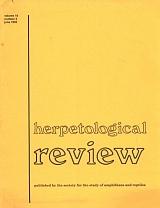




Related bibliographies:
Reptiles
 Lizards Lizards
 Pygopodidae Pygopodidae
Australia
Malay Archipelago






































































































































































































































































































































| |

Bibliography of the genus
Lialis (Long-headed Scaly-foots)

(Reptilia: Sauria: Pygopodidae)
Note:
In order to limit redundancy, relevant literature indexed in the related bibliographies in the left column may not have been included in this page. For a comprehensive search of literature, these bibliographies should therefore also be consulted.
Lialis in general
 |
Iordansky, N.N. 2004. [Jaw apparatus in Lialis (Lacertilia, Pygopodidae): ways of intensifying cranial kinesis and a problem of snake origin]. (In Russian, English summary). Zoologicheskii Zhurnal 83(1): 93-104.
Kinghorn, J.R. 1924. A short review of the lizards belonging to the genus Lialis Gray. Records of the Australian Museum 14: 184-188.
Neill, W.T. 1957. Notes on the pygopodid lizards, Lialis burtoni & L. jicari. Copeia 1957: 230-232.
Spinner, M.; Gorb, S.N.; Westhoff, G. 2013. Diversity of functional microornamentation in slithering geckos Lialis (Pygopodidae). Proceedings of the Royal Society Biological Sciences Series B 280(1772): 20132160, 1-9.
|
Lialis burtonis
 |
Bradshaw, S.D.; Gans, C.; Saint Girons, H. 1980. Behavioural thermoregulation in a pygopodid lizard Lialis burtonis. Copeia 1980(4): 738-743.
Brown, G.P.; Greenlees, M.J.; Phillips, B.L.; Shine, R. 2013. Road transect surveys do not reveal any consistent effects of a toxic invasive species on tropical reptiles. Biological Invasions 15(5): 1005-1015.
Fearn, S.; Trembath, D. 2004. Observations on body size, reproduction and food habits of Burton's Legless lizard (Lialis burtonis; Pygopodidae) from Townsville and Magnetic Island, North Queensland. Herpetofauna (Sydney) 34(2): 78-80.
Gorman, G.C.; Gress, F. 1970. Sex chromosomes of a pygodid lizard Lialis burtonis. Experientia 26: 206-207.
Hoser, R. 1983. Notes on egg laying in the scalyfoot (Pygopus lepidopus) and other reptiles. Herptile 8(4): 134-136.
Hoser, R. 1985. Notes on the feeding behaviour of the common scaly foot (Pygopus lepidopus) and Burton's legless lizard (Lialis burtonis). Herptile 10(3): 93-94.
Longley, G. 1945. Notes on Burton's legless lizard (Lialis burtoni). Proceedings of the Royal Zoological Society of New South Wales 1944-45: 33-34.
Maryan, B. 1987. Notes of reproduction in captive Lialis burtonis. Western Australian Naturalist 16(8): 190-191.
Maryan, B. 1991. New herpetofauna records of Wongan Hills. Western Australian Naturalist 18(6): 169.
Murray, B.A.; Bradshaw, S.D.; Edward, D.H. 1991. Feeding behavior and the occurrence of caudal luring in Burton's pygopodid Lialis burtonis (Sauria: Pygopodidae). Copeia 1991(2): 509-516.
O'Shea, M.T. 1987. Prodigious saurophagy in legless lizards. Herptile 12(2): 68-71.
Patchell, F.C.; Shine, R. 1986. Feeding mechanisms in pygopodid lizards: how can Lialis swallow such large prey? Journal of Herpetology 20(1): 59-64.
Patchell, F.C.; Shine, R. 1986. Hinged teeth for hard-bodied prey: a case of convergent evolution between snakes and legless lizards. Journal of Zoology (A) 208(2): 269-275.
Peters, U. 1976. Seltsame Reptilien Australiens. Aquarium Aqua Terra 10(90): 557-562.
Peters, U. 1986. Fusslose Echsen. Zwei Beispiele aus der Familie Pygopodidae. Aquarium (Bornheim) 210: 657-659.
Pianka, E.R. 2010. Notes on the ecology of four species of pygopodid lizards in the Great Victoria desert. Western Australian Naturalist 27(3): 175-181.
Schlüter, U. 2004. Lialis burtonis Gray, 1835 Burton Spitzkopf-Flossenfuss. Reptilia (D) 9(47): 51-54.
Schlüter, U. 2011. [Burton's legless lizard (Lialis burtonis Gray, 1835) in the terrarium]. (In German). Elaphe 19(4): 41-45.
Tanner, V.M. 1952. Pacific islands herpetology. 6. Tahiti and Marquesas Islands, New Guinea and Australia. Great Basin Naturalist 12: 1-12.
Wall, M.; Shine, R. 2007. Dangerous food: lacking venom and constriction, how do snake-like lizards (Lialis burtonis, Pygopodidae) subdue their lizard prey? Biological Journal of the Linnean Society 91(4): 719-727.
Wall, M.; Shine, R. 2008. Post-feeding thermophily in lizards (Lialis burtonis Gray, Pygopodidae): laboratory studies can provide misleading results. Journal of Thermal Biology 33(5): 274-279.
Wall, M.; Shine, R. 2009. The relationship between foraging ecology and lizard chemoreception: can a snake analogue (Burton's legless lizard, Lialis burtonis) detect prey scent? Ethology 115(3): 264-272.
Wall, M.; Shine, R. 2013. Ecology and behaviour of Burton's Legless Lizard (Lialis burtonis, Pygopodidae) in tropical Australia. Asian Herpetological Research 4(1): 9-21.
Wall, M.; Thompson, M.B.; Shine, R. 2013. Does foraging mode affect metabolic responses to feeding? A study of pygopodid lizards. Current Zoology 59(5): 618-625.
Weber, E.; Werner, Y. 1977. Vocalizations of two snake-lizards (Reptilia: Sauria: Pygopodidae). Herpetologica 33(3): 353-363.
Wever, E.G. 1974. The ear of Lialis burtonis (Sauria: Pygopodidae), its structure and function. Copeia 1974(2): 297-305.
|
Lialis jicari
 |
Patchell, F.C.; Shine, R. 1986. Hinged teeth for hard-bodied prey: a case of convergent evolution between snakes and legless lizards. Journal of Zoology (A) 208(2): 269-275.
|
| | 














































































































































































|

